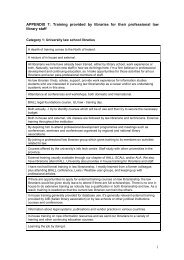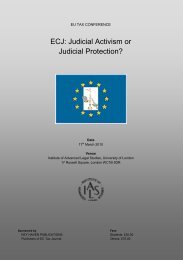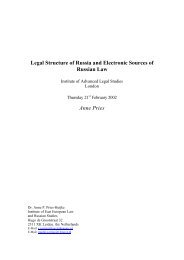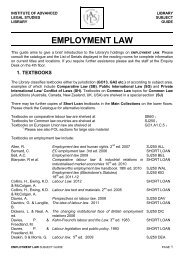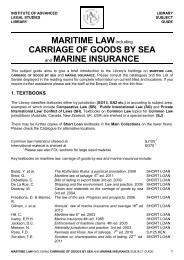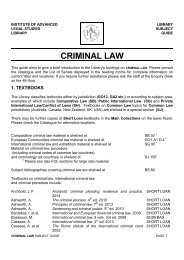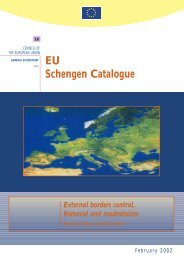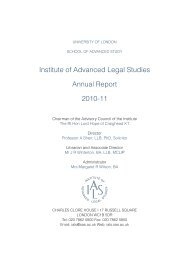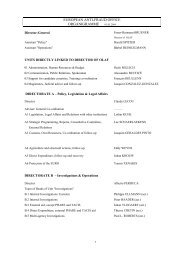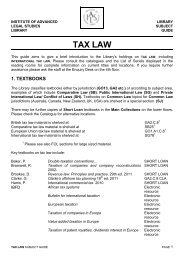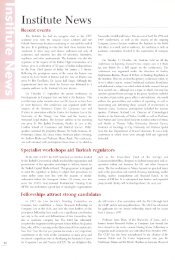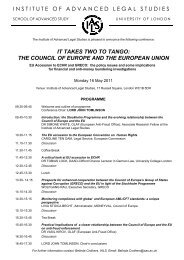a thesis - Institute of Advanced Legal Studies
a thesis - Institute of Advanced Legal Studies
a thesis - Institute of Advanced Legal Studies
Create successful ePaper yourself
Turn your PDF publications into a flip-book with our unique Google optimized e-Paper software.
CONSTRUCTIVE TRUSTS. 113<br />
40 Ch. D. at p. 381). " It is that a stranger to the trust receiving<br />
money from the trustee which he knows to be part <strong>of</strong> the trust<br />
estate is not liable as a constructive trustee, unless there are facts<br />
brought home to him which show that to his knowledge the money<br />
is being applied in a manner which is inconsistent with the trust;<br />
or (in other words) unless it be made out that he is party either to<br />
a fraud, or to a breach <strong>of</strong> trust on the part <strong>of</strong> the trustee."<br />
Again, the substance <strong>of</strong> Mr. Justice Kekewich's judgment in<br />
In re Barney (1892, 2 Ch. 265) is that before a person can be<br />
declared a constructive trustee, it must be shown that he has<br />
actually participated in fraudulent conduct on the part <strong>of</strong> the<br />
trustee, or that trust property is [in breach <strong>of</strong> the trust, as he<br />
knows] either actually vested in him, or so far under his control,<br />
that he is in a position to require it to be vested in him.<br />
It seems, moreover, from the case <strong>of</strong> Coleman v. Sucks and Oxon<br />
Union Bank (1897, 2 Ch. 243), that an agent receiving trust money<br />
from a trustee is not liable as a constructive trustee merely because<br />
he knows the money he is receiving is trust money. He must<br />
know that it is a breach <strong>of</strong> trust for the trustee to pay it to him.<br />
(See pp. 254 and 255 <strong>of</strong> the report.)<br />
The following cases illustrate the application <strong>of</strong> these principles<br />
:—<br />
Illustrations.<br />
A.— Cases in which Agent held liable as Trustee.<br />
1. A., a trustee, keeps a trust account and a private account with<br />
B. and C., bankers. A., being indebted to B. and C. on his private<br />
account, draws a cheque on the trust account and pays it to the<br />
credit <strong>of</strong> his private account. B. and C. know that the moneys represented<br />
by the cheque are trust moneys. They are liable as constructive<br />
trustees to refund the amount to the beneficiaries. Panncll<br />
v. Hurley (1845), 2 Coll. C. C. 241. Foxton v. Manchester, fyc.<br />
Hanking Co. (1881), 44 L. T. 406, is similar. Both cases are distinguished<br />
in Coleman v. Bucks and Oxon Union Bank, (1897) 2 Ch.<br />
243.<br />
2. A. and B., trustees holding a fund in trust for C. for life, remainder<br />
for D. for life, with remainder over, open a trust account<br />
with X. and Y., their bankers, and pay to the credit <strong>of</strong> the account a<br />
sum <strong>of</strong> 7701. D. owes X. and Y. 7501. on a bill <strong>of</strong> exchange, and<br />
being unable to pay it, at the suggestion <strong>of</strong> X. and Y., and without<br />
H. *



